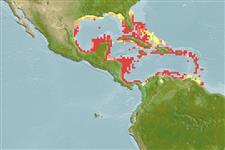Environment: milieu / climate zone / depth range / distribution range
Ökologie
seewasser riff-verbunden. Tropical; 32°N - 6°N, 99°W - 56°W
Western Central Atlantic: Florida (USA), Bahamas and throughout the Caribbean. Absent from the Gulf of Mexico.
Size / Gewicht / Alter
Maturity: Lm ? range ? - ? cm
Max length : 12.7 cm TL Männchen/unbestimmt; (Ref. 13442)
Adults pale yellow; usually darker dorsally; grayish yellow that pales ventrally. Iridescent blue dorsal-ventral lines on head, sometimes extending to the leading edge of pelvic fins. One distinct blue line encircles the orbit and extends ventrally on each side of the fish. Two black pigment spots are sometimes found on the snout region of the nares. A large black saddle on caudal peduncle, extending below the lateral line on each side of the fish. Pelvic fins yellowish, pectorals clear.
Mainly carnivorous (Ref. 13810). Has been reared in captivity (Ref. 35420).
Life cycle and mating behavior
Geschlechtsreife | Fortpflanzung | Ablaichen | Eier | Fecundity | Larven
Domeier, M.L., 1994. Speciation in the serranid fish Hypoplectrus. Bull. Mar. Sci. 54(1):103-141. (Ref. 26407)
IUCN Rote Liste Status (Ref. 130435)
Bedrohung für Menschen
Harmless
Nutzung durch Menschen
Aquarium: Kommerziell
Mehr Information
NamenSynonymeMetabolismusRäuberÖkotoxikologieFortpflanzungGeschlechtsreifeAblaichenSpawning aggregationFecundityEierEientwicklung
ReferenzenAquakulturAquakultur ProfilZuchtlinienGenetikElectrophoresesVererbbarkeitKrankheitenVerarbeitungNutrientsMass conversion
PartnerBilderStamps, Coins Misc.LauteCiguateraGeschwindigkeitSchwimmstilKiemenoberflächeOtolithsGehirngrößeSehfähigkeit
Tools
Zusatzinformationen
Download XML
Internet Quellen
Estimates based on models
Preferred temperature (Ref.
123201): 25.6 - 28.2, mean 27.4 °C (based on 530 cells).
Phylogenetic diversity index (Ref.
82804): PD
50 = 0.5000 [Uniqueness, from 0.5 = low to 2.0 = high].
Bayesian length-weight: a=0.01778 (0.00680 - 0.04650), b=3.03 (2.80 - 3.26), in cm total length, based on LWR estimates for this (Sub)family-body shape (Ref.
93245).
Trophic level (Ref.
69278): 4.0 ±0.65 se; based on food items.
Widerstandsfähigkeit (Ref.
120179): hoch, Verdopplung der Population dauert weniger als 15 Monate. (Preliminary K or Fecundity.).
Fishing Vulnerability (Ref.
59153): Low vulnerability (10 of 100).
Nutrients (Ref.
124155): Calcium = 86.1 [46.0, 180.4] mg/100g; Iron = 0.676 [0.349, 1.314] mg/100g; Protein = 18.1 [16.2, 19.9] %; Omega3 = 0.133 [0.075, 0.229] g/100g; Selenium = 23.2 [12.2, 48.5] μg/100g; VitaminA = 101 [26, 450] μg/100g; Zinc = 1.31 [0.82, 2.02] mg/100g (wet weight);
